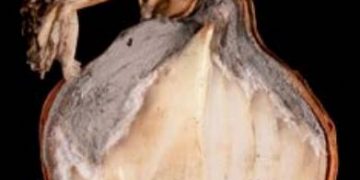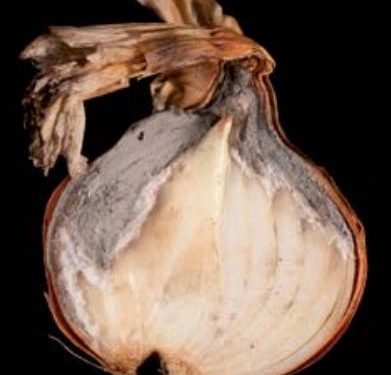First described in the USA in 1917, neck rot can be a major source of losses in stored bulb onions. The extent of losses is variable. Losses of over 50% were reported in the late 60s and early 70s and, more recently, losses of up to 40% have been reported in individual crops.
The disease can be caused by three different species of Botrytis: B. aclada, B. allii, and B. byssoidea.
Neck rot is primarily seed-borne. Infested seed can be contaminated externally and/or internally and the pathogen may survive on seed for several years. Infested seeds give rise to infected seedlings as a result of direct infection of the tips of the cotyledons from spores or mycelium on or within the seed coat during germination and emergence.
Typically, neck rot symptoms only become apparent after onion bulbs have been harvested and stored for some time (2–3 months). Symptoms are not generally seen in the field, so that bulbs which appear sound and healthy (but nevertheless latently infected) at harvest may be rotten/unmarketable when stores are opened. As the name implies, neck rot infection results in a light-brown to brown wet rot that normally begins in the neck area of the bulb and progresses downwards into the scale tissues, with no external symptoms. Eventually the infection can spread to the entire bulb. Whitish fungal mycelium develops on infected tissues and between the scales, producing dense masses of grey fungal spores (conidia). Black sclerotia (hardened resting bodies consisting of a mass of fungal mycelium) may develop under the outer skin of the decaying bulbs. Infections may develop in any part of the bulb as a result of damage. As well as the obvious losses in storage, neck rot may also reduce emergence and kill seedlings, reducing plant populations. Infection may affect seedling vigour.
Source: https://ahdb.org.uk/































